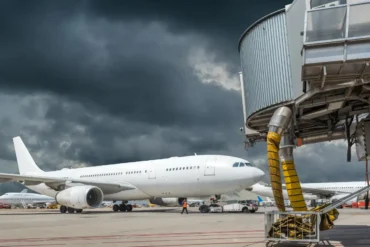Have you ever noticed that airliners have horns like cars do? But unlike a car horn’s familiar honking sound, an airplane’s horn has a unique, alarm-like tone. While pilots don’t use them much during flights, these horns play an important role when the plane is on the ground. The horns help get the attention of maintenance crews working on the aircraft.
The Boeing 737 is one model that has a horn switch right on the cockpit’s overhead panel. This lets pilots easily set off the loud horn when they need a maintenance team’s attention or for certain situations on the ground. In this article, we’ll lift the veil on airplane horns and see how they work in the complex world of aircraft operations.
If you expected airplane horns to sound just like a car’s honking horn, think again! Airliner horns make a startling, siren-like noise instead of a conventional honk. A fascinating 2019 video from Royal Dutch Airlines (KLM) showcased the unique sound of their aircraft’s horn, which resembled a car alarm more than a typical horn blast.
Every plane has a “ground call button” that serves a similar function to the horn, but with its own distinct sound. Found on the overhead panel near the switch pilots use to contact the cabin crew, this button gets pressed when the flight crew needs to get the attention of ground personnel.
How Do Pilots Use These Special Horns?
The small overhead switch labeled “GRD CALL” or “GND” allows pilots to activate the unique horn. As KLM has explained, pilots sound the loud alarm when they need someone’s attention while out on the tarmac. Interestingly, it’s not meant for talking to flight attendants, since they may not hear it or realize what it means, as one pilot pointed out on Quora.
For the most part, aircraft horns get used in certain emergency situations. But surprisingly, pilots aren’t the main ones using them. Ground crews operate the switch more often, usually when maintenance tasks are being done in the cockpit. KLM noted the horn’s purpose is for ground teams to alert their co-workers down below on the ground.
More Than a Beep: The Real Purpose of Airplane Horns
Unlike car horns that warn of danger, an aircraft’s horn serves a different function. It’s not really a cautionary tool on a plane. Instead, it’s a vital communication device for ground crews during maintenance activities in the hangar.
How Are These Unique Horns Not Used?
Pilots rarely sound the horn, mainly because there’s no need to. According to some pilots, they don’t have much reason to use the horns during pre-flight checks. With all the ambient noise of aircraft engines and ground operations, the horn just isn’t that practical. It also automatically shuts off after takeoff, so it can’t be used inflight.
While the horn is one way to communicate, it’s not the only method planes have to convey warnings. Modern airliners have multiple systems designed to effectively alert engineers about safety issues.
Aircraft use a variety of specialized siren-like sounds to notify crews of system failures, fires, or other problems. These warning signals are engineered to identify specific system threats so engineers and mechanics can respond appropriately.


















